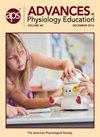Why ask why? Toward coordinating knowledge of proximate and ultimate explanations in physiology
IF 1.7
4区 教育学
Q2 EDUCATION, SCIENTIFIC DISCIPLINES
引用次数: 0
Abstract
In physiology education, students must learn to recognize and construct causal explanations. This proves difficult, in part, because causal explanations in biology manifest in different varieties. Unlike other natural sciences, causal mechanisms in physiology support physiological functions and reflect biological adaptations. Therefore, students must distinguish between questions that prompt a proximate or an ultimate explanation. In the present investigation, we aimed to determine how these different varieties of students' knowledge coordinate within students' written explanations. Prior research in science education demonstrates that students present specific challenges when distinguishing between proximate and ultimate explanations-students appear to conflate the two or construct other non-mechanistic explanations. This investigation, however, demonstrates that analytic frameworks can distinguish between students' proximate and ultimate explanations when students are provided explanatory scaffolds that contextualize questions. Moreover, these scaffolds and prompts help students distinguish between physiological functions and the cellular and molecular mechanisms that underpin them. Together, these findings deliver insight into the context-sensitive nature of student knowledge in physiology education and offer an analytic framework for identifying and characterizing student knowledge in physiology.为什么要问为什么?协调生理学中近似解释和终极解释的知识
在生理学教育中,学生必须学会识别和构建因果解释。事实证明这很困难,部分原因是生物学中的因果解释有不同的表现形式。与其他自然科学不同,生理学中的因果机制支持生理功能并反映生物适应性。因此,学生必须区分问题是提示近似解释还是最终解释。在本次调查中,我们旨在确定这些不同类型的学生知识在学生的书面解释中是如何协调的。先前的科学教育研究表明,学生在区分近似解释和终极解释时面临特定的挑战--学生似乎会混淆两者或构建其他非机理解释。然而,这项调查表明,如果为学生提供解释性支架,将问题情境化,分析框架就能区分学生的近似解释和终极解释。此外,这些支架和提示有助于学生区分生理功能和支持生理功能的细胞和分子机制。这些发现共同揭示了生理学教育中学生知识的情境敏感性,并为识别和描述生理学中的学生知识提供了一个分析框架。
本文章由计算机程序翻译,如有差异,请以英文原文为准。
求助全文
约1分钟内获得全文
求助全文
来源期刊
CiteScore
3.40
自引率
19.00%
发文量
100
审稿时长
>12 weeks
期刊介绍:
Advances in Physiology Education promotes and disseminates educational scholarship in order to enhance teaching and learning of physiology, neuroscience and pathophysiology. The journal publishes peer-reviewed descriptions of innovations that improve teaching in the classroom and laboratory, essays on education, and review articles based on our current understanding of physiological mechanisms. Submissions that evaluate new technologies for teaching and research, and educational pedagogy, are especially welcome. The audience for the journal includes educators at all levels: K–12, undergraduate, graduate, and professional programs.

 求助内容:
求助内容: 应助结果提醒方式:
应助结果提醒方式:


